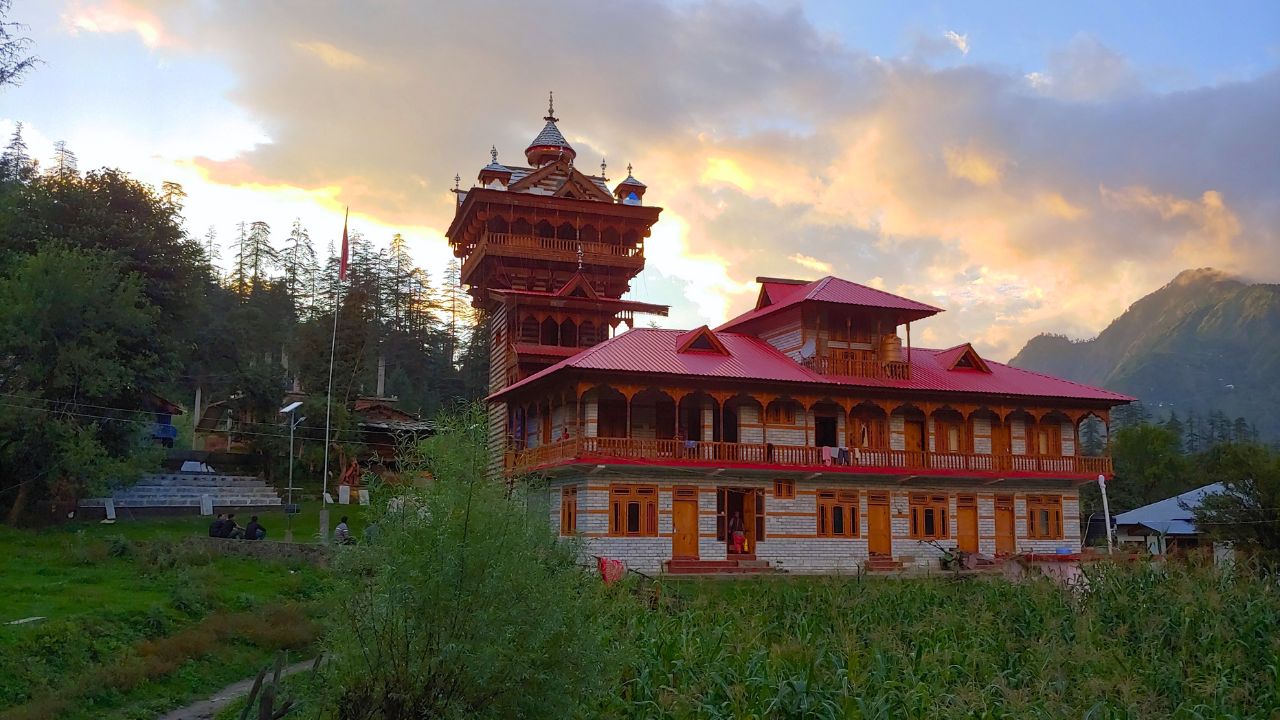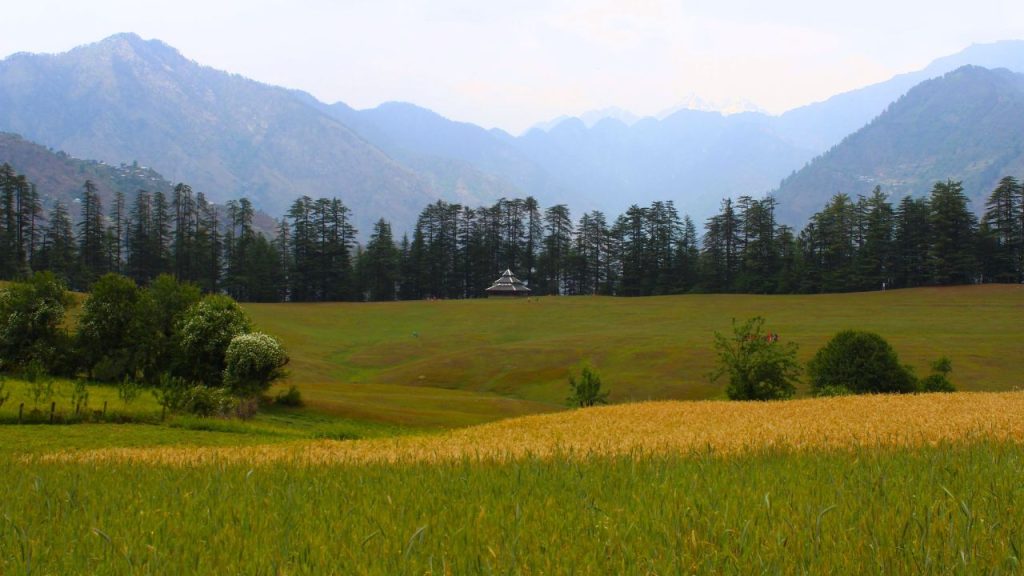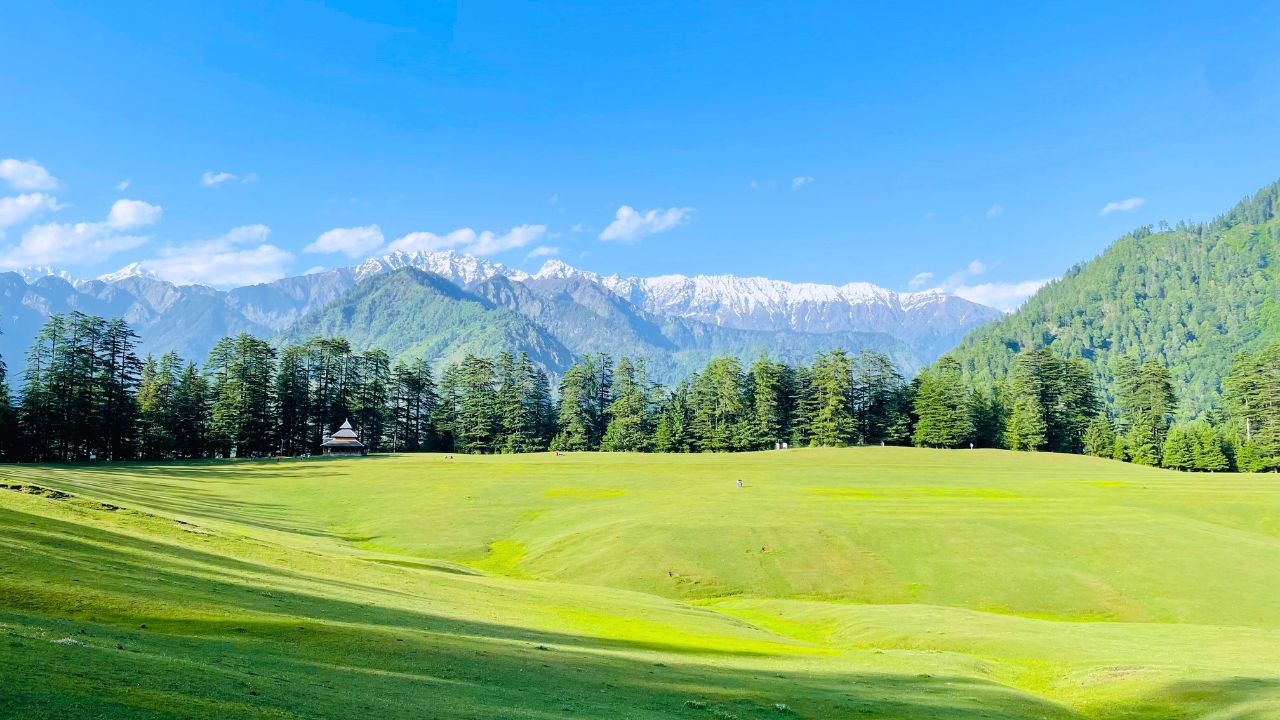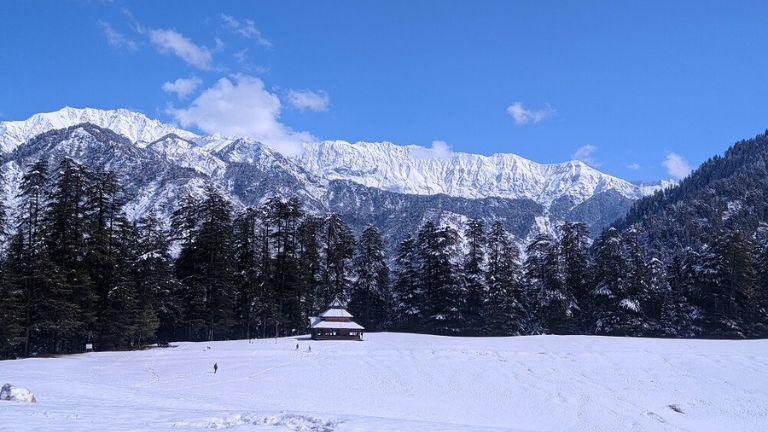Shangarh Sainj Valley is a tiny village in Himachal Pradesh, which is the northernmost state of India. This place, Shangarh, is wholly filled with the spectacular beauty of Himachal. In addition to this, one other valley, known as Sainj Valley, has been designated. Shangarh comes under the Great Himalayan National Park, a UNESCO World Heritage Site, which is known for its dark-covered forest with many species of flora and fauna.
Every year, so many unknown solo travelers, hikers, and trekkers come to visit this magical place, Shangarh. This place is considered one of the holy lands in Himachal Pradesh. The perfect beauty of Shangarh was reflected in the bright blue sky and grey clouds, as well as the untouched snowy peaks of the hills. Let’s gain more detailed information about the Shangarh Sainj Valley.
- Location
- How do I reach Shangarh?
- ROUTE TO REACH Shangarh VIA ROAD
- Why should you visit Shangarh?
- Where should I stay in Shangarh?
- Where to eat?
- What can you do in Shangarh?
- Trekking Trails in Shangarh
- Let’s discuss about treks in Shangarh
- Long trekking trails is Shangarh and Sainj Valley
- Around Shangarh:
- Weather in Shangarh or Sainj Valley
- Best time to visit Shangarh Sainj valley
- Network Connectivity
- ATM & Cash
- Medical facilities
- F&Q's Shangarh Sainj Valley
Location
Shangarh is in the Sainj valley of Himachal Pradesh. This valley is in the Kullu district of Himachal Pradesh and is 6900 feet above sea level. Shangarh Sainj Valley comes under the environmental conservation region of GHNP, which is why the place comes under the Wildlife Act’s protection. So many travelers who come to visit Himachal Pradesh every year aren’t even aware of this offbeat place like Shangarh Himachal. But we can give you surety that if you come here once, then you will fall in love with the beauty of this charming Shangarh.
How do I reach Shangarh?
The best way to reach Shangarh Himachal Pradesh is by road. To get to Shangarh, there are two options. First, as an option, you can come through Shimla via Jalori Pass; second, you can come through the Delhi-Manali highway via Mandi in between. The distance from Shimla to Sainj Valley is 195 km.
You also have the option to come via Manali and go back via the Shimla route. If you are traveling from Delhi, both routes will take you to Shanghai in about the same amount of time.
By Train
If you are coming from any part of India, you can take a train, but you have to get off at Joginder Nagar Railway Station first, which isn’t very close to Shangarh.
That’s why we, in real Himachal, suggest you come to Chandigarh by train. Then you can hire a taxi, and a shared cab is available so that you can reach Shangarh, Himachal Pradesh. That is 233 km (approx.) away from the Sainj valley.
By Air
If you are coming by air, you have to take a flight to Delhi or Chandigarh. After that, you can hire a taxi, which is easily available at the airport.
By Bus
If you take the bus, you must arrive at the Aut stop, which is two hours away from Manali.
There are a few ways to get to Shangarh from Aut.
For that, you must travel to Sainj town.
Sainj has a hydroelectric power plant and is home to the main market that serves the nearby villages.
You can come to Sainj town on a bus for INR 70 and then take a shared taxi or a lift the 10 kilometers to Shangarh. You can get to Shangarh from Sainj for about INR 700 if you take a cab.
Other Option
You can board a bus that travels via Sainj and stops in Neuli. From there, you can either hire a private cab, take a ride, or walk to Shangarh.
A shared cab will run you about INR 300 from Ropa, where the bus will drop you off.

ROUTE TO REACH Shangarh VIA ROAD
Delhi –to Karnal– Ambala – Kharad bypass – Ropar – Keeratpur Sahib – Swarghat to Bilaspur -SunderNagar – Mandi – Aut tunnel before the tunnel – Larji – Sainj bypass – Ropa -Shangarh
| Location | Distance (Km) |
| Aut to sainj | 18 km |
| Aut to Neuli via Sainj | 27 km |
| Sainj to Ropa | 07 km |
| Ropa to Shangarh | 10 km |
| Sainj to Dehuri | 10 km |
Why should you visit Shangarh?
These are the reasons why you should visit Shangarh. If you are someone who loves to spend their precious time in the lap of nature with majestic views of blue skies and the green beauty of valleys, you will enjoy spending time with the locals of the hills on trails in the Himalayas.
Where should I stay in Shangarh?
Shangarh is one of the offbeat destinations in Himachal. However, the natural beauty of Shangarh is still untouched, which is why there are only a few homestays available in the city that are operated by the locals of this majestic Shangarh. Here are a few recommendations by Real Himachal. where you can stay:
Into the wild: Intp the wild homestay located at the shaangarh , sainj valley at Himachal Pradesh. They have two properties, both with stunning panoramas; the first, formerly called Teja Homestay, overlooks the Shangarh Meadows and can be reached by car and a short walk, while the second can be reached on foot in about 10 to 12 minutes. This land is also the site of a luxury geodesic dome construction project.
Zostel Shangarh : tucked away inside the Great Himalayan National Park’s dense forest. This backpackers’ hostel in Himachal, India, is close to some of the most beautiful snow-capped mountains in the world. It has a peaceful, meditative atmosphere because of this. The large rooftop common area serves as the hostel’s nerve center, and it’s filled with amenities like a giant hammock, swings, a library, and internet-connected computers. In addition to its convenient location, the hostel’s private balconies, proximity to popular restaurants, and outdoor spaces make it a great place for guests to work, explore, and make new friends.
The hosteller Shangarh : Shangarh Guesthouse, Sainj Valley. The backpacker hostel is the best place to be if you’re looking for an unusual and wonderful retreat, as it is a cozy property right next to the great and lush Shangarh meadows. There are only three dormitories and three common rooms, but the unique allure and beauty of this spot are undeniable. It’s the ideal place for vacationers to escape from the stresses of modern life and give themselves over to the care of nature for a few days. Enjoy the convenience of today’s amenities such as running water, Wi-Fi, round-the-clock power, and parking spaces, all without giving up the charm of a truly one-of-a-kind setting.
Shangarh Kothi: Shan’e’Ghar Kothi is a sheer experience of local Himachali culture, food and traditions. Shangarh Koti is Hotel in Shangarh comfortable and spacious hotel offer a perfect blend of authentic design using local materials. Kath kuni architexture is indigenous to the himalyan region which involves alternately stacking wooden beams and stones that can go even up to seven floors. ne can enjoy the stay under himalayan skies and unquestionable hospitality for 3500 Rs per night including breakfast.

Where to eat?
You can explore many dishes in cafes and restaurants in Shangarh which serve many cuisines, from Indian to Chinese and Continental, with the majestic beauty of Shangarh and sainj valleys in Himachal Pradesh. The cafe’s local+modern vibe, stunning vista, and occasional live performances make it a must-visit when in Shangarh. The cafe is also unique in that it is the only place where one can get such a wide range of options without sacrificing the quality of their food or their ability to keep the prices low.
What can you do in Shangarh?
Visit Shangarh Meadows : Shangarh is a village that is surrounded by the beautiful Himalayan hills and the Parvati Pass. It is one of the most photogenic places in the Himalayas. But if you just want to explore the majestic views of this place, Real Himachal suggests that you please take care of the spiritual vibrations and aura of this pure location.
Enjoy the sunrise and sunsets : The beauty of this shrine is witnessed by sunrises and sunsets. Its attractiveness is potent enough to soften even the coldest hearts. It inspires, refreshes, restores, and gives hope. Hike up to No Society Cafe, located just 800 meters from the center of the village, and experience the best of both worlds, with the gentle warmth of the sun at sunrise and the soothing glow of the setting sun at sunset.
Explore the local beauties: There are a few small towns near Shangarh. Some of them are Tandi, BarShangarh, and Maidana. You’ll be awestruck as you wander through these mountain communities, which feature homes built in the traditional kulluvi style and are surrounded by apple orchards and a way of life that is based on agriculture. The locals are very friendly, and you can easily strike up a conversation with them about the region’s rich history or the many legends that have been passed down through the generations.
Bird watching is still here: Because of its proximity to the Great Himalayan National Park, the town of Shangarh is home to 131 different bird species. Birds of the Monal and Jujurana genera are extremely rare, making their sightings all the more exciting when they are made. At the park’s lower elevations during the winter, yellow-bellied Fantails, Wallcreepers, White-collared, and Grey-winged blackbirds are common. From a vantage point in the village early in the morning, you can see the Blue Magpie, Ravens, and Long-tailed Minivets that call Shangarh home.
Trekking Trails in Shangarh
Shangarh is also included in trekkers’ trails because it is from here that you can begin your trekking journey. This beautiful place has both long and short trekking trails, so people who are new to trekking can start their journeys to see the beauty of the Himalayas that hasn’t been seen yet.
Many beautiful hikes leave from Shangarh. Starting from No Society Cafe, the 4- to 5-hour Jangaon Thach hike has a moderate difficulty level and is not too strenuous for most hikers. The overnight trek to Thini Thatch ranges in difficulty from easy to moderate. Another lush green meadow, Thini is surrounded by snowy mountains. Another nearby hike is the famous Pundrik Lake, which is a 10-minute drive from Shangarh and a kilometer walk through a meadow to a lake.
Let’s discuss about treks in Shangarh
Sara Lake: Sara lake is nested between the green meadows of Shangarh. The water in this lake appears black from a distance, but when you scoop some out of your hand, it turns blue. You can clearly see the difference; it is completely clean and clear. This is 3 to 4 hours away from the Barshangarh waterfall. The other option is to go through Lapah Village. And if you are planning to do the trek on this hike, you can make base camp at theLapahh village and stay near Sara Lake.
Lapah Village : A short, easy trek to La Pah village will be completed in 4 to 5 hours. This is a great example of the beauty of flora and fauna in green, open grassland. There are also some homestays and camping options available here. After completing a trek to Lapah village, you can continue your trekking journey to Sara Lake and Shumga Thach from Lapah.
Ganjau Thach : Ganjau thach is located in between the dense forest of the Himalayas. There is a natural spring running from Ganjau Thrach, which is the source of water for the Shangarh. Locals also said the water from this spring contains many nutrients. You can complete this trek in 3 to 4 hours, and after that, you can also enjoy some bonfires and camping as well.
Thihani Thach: Thihani Thach, which shares the same path as Ganjau Thach, is another incredible location in Shangarh. The peak is the highest point in Shangarh village and can be reached after a three to four hour hike. On top of this Thach stands a temple dedicated to Kaali Mata. Here, you can take in a breathtaking panorama of the surrounding mountains and valleys from every angle. Sunsets from Thihani top are not to be missed. Camping is also an option.
Shumga Thach : One of the most well-known routes for hikers is the Shangarh to Shumga thach, which passes by BarShangarh and Sara Lake. The hike is doable in a couple of days. Many travel agencies offer packages that include this hike. It’s a great spot to relax and take in the stunning scenery. Shumga Thach is a scenic meadow in the mountains that looks out over the Himalayas, valleys, rivers, and distant settlements. Animals and plants, including some useful ones, thrive in Shumga Thach. Until late May or early June, this area is covered in snow.
Long trekking trails is Shangarh and Sainj Valley
Dal Thach Trek : Traveling along the Sainj river for four to five days will bring you to the beautiful Dhel Meadow, where you can take in the views of the surrounding mountain ranges. Dhel meadow can be visited as part of a trek to Raktisar, or on its own as part of a trip to the area. This area is a vital link between Tirthan and Sainj Valley, and it also happens to be home to a wide variety of plant and animal life. The beautiful array of springtime hues in the meadow is sure to win your heart.
Jiwa Nala Trek: The Jiwa Nala Trek is a seven-day trek from Neuli village to Parvati Valley. includes a wide range of natural features, from glaciers and rivers to waterfalls and thick forests at high altitudes. Do not forget that a trek permit is essential for this journey.
Raktisar Trek : The Sainj River can be traced back to its origin on this, one of many lengthy hikes. The trek has long been popular amongst international visitors, but in recent years, interest from Indian tourists has increased as well. In the course of your 7-8 day hike, you will gain an elevation of about 12,800 feet. Locals use the word “ultimate” to describe both the trip and the destination. This pristine hike will take you alongside the Sainj river, small water streams, forests, and stunning views of the mountains. Lake Raktisar’s water appears red (hence, rakt – blood) from afar but is crystal clear when scooped up in the palms of your hands. The area is steeped in legend and folklore. Since Raktisar is within GHNP, you will need a permit to visit there.

Around Shangarh:
Visit Shangchul Mahadev Temple
A short walk will lead you to the Shangchul Mahadev Temple, a towering structure that stands out in the otherwise unremarkable village of Shangchul. The wooden temple is a beautiful sight because it was built in the traditional Kath Kuni style. The ornate doorway of the Shangchul Mahadev temple has intricate carvings that add to the building’s luxury.
Sharchi is a beautiful village in the Kullu district of Himachal Pradesh. It is about four to five hours by car from Shangarh. On my trip to India and Pakistan in June of 2019, I made a stop here as well as in Shangarh. Having done extensive research on Sharchi, I have written this extensive blog post.
BarShangarh Waterfalls
This stunning waterfall, known as BarShangarh, can be found just 3 kilometers from the Shangarh community. Getting here can be done in a couple of different ways. You can either hike the 15 minutes to the waterfall from the parking area or drive to the waterfall’s starting point. The other choice is to hike the 45 minutes from Shangarh to the top.
We Real Himachal recommend a trek to BarShangarh waterfall because it goes through cute villages and beautiful natural scenery, like dense forests, water streams, and a lot of plants. One of the most frequented spots is the BarShangarh Waterfall. If you’re looking for some peace and quiet, this waterfall is the place to do it. BarShangarh, another nearby village, is also worth a look.
Weather in Shangarh or Sainj Valley
Shangarh is accessible all year because the weather in Shangarh and Sainj Valley is pleasant. You can visit when you want. Because it is between the Himalayas and the Pacific Ocean, the windy breeze will be there all year.
In Winters
Shangarh welcomes you in the winter with snowcapped mountains and brisk winds. You can also witness snowfalls in Shimla and Himachal Pradesh’s majestic meadows.
In Summer
The weather will be pleasant during the summer months, which are April to June, in comparison to the winter months. This is also a peak season when trekkers come to visit Shangarh to see the pure aura of nature.
In Monsoon
In the months of July and September, it is okay to visit. However, we at Real Himachal advise against visiting during the monsoon season. Because Shangarh lacks rivers, this location is prone to flooding, heavy thunderstorms, and landslides.
However, if you have already planned a trip to Shangarh during the monsoon, we only recommend that you speak with or try to contact the locals of your destination.
Best time to visit Shangarh Sainj valley
Based on the information provided thus far, we can conclude that the best time to visit Shanghai is during the summer. In other words, between the months of April and June. This is the time of year when the weather is nice and you can see the raw, natural aura of this magical town.
Network Connectivity
Shangarh and the Sainj Valley have great network connections. None of the three major networks (Airtel, BSNL, or Jio) have had any problems. Do not presume that your Vodafone network will function here.
ATM & Cash
Sainj town is home to both an HDFC and an SBI ATM. HDFC deserves more of your trust. That’s why real Himachal always advises carrying cash while traveling.
Medical facilities
There’s a Community Health Centre (CHC) in Sainj town and a private clinic run by Mr. Ajay in Sainj.
F&Q’s Shangarh Sainj Valley
Is Shangarh worth visiting?
This is the spot to be if you could only choose one location in the valley (don’t do that, but still!). You’ll have a difficult time finding a more serene location when you’re completely surrounded by nature. Additionally, this area has a cozy forest rest house.
How is Shangarh?
The “meadows,” which were the focal point of the village’s creation and are encircled by the gorgeous mountains of the Pin Parvati Pass, are its most famous and picturesque location. In order to preserve the meadows’ meditative and peaceful atmosphere, there are a few limited areas that must be respected and cared for.
How can I reach AUT to Shangarh?
Take a bus to Sainj from Aut. There is only one bus from Sainj that travels to Shangarh, and it departs at 4:00 PM. Rest you can take a private Cab or Taxi too.
Why is Tirthan Valley famous?
The verdant meadows, its unique wild flora, and the natural springs in the Tirthan valley, which is located in the seclusion of the Himalayas, personify the valley’s beauty. The breathtaking waterfalls are a photographer’s dream because they provide exceptional chances to take beautiful photos of the lush green surroundings.








